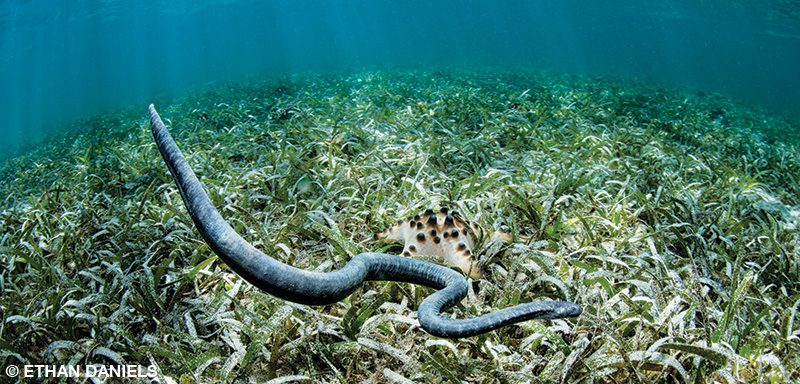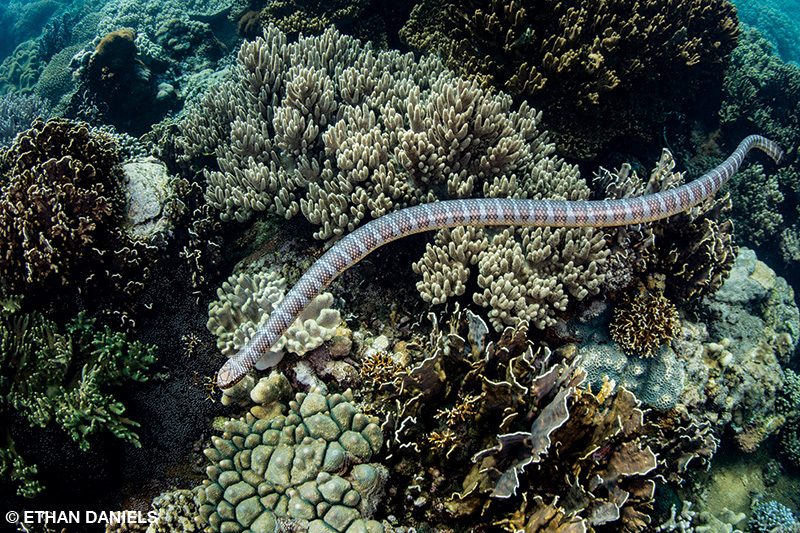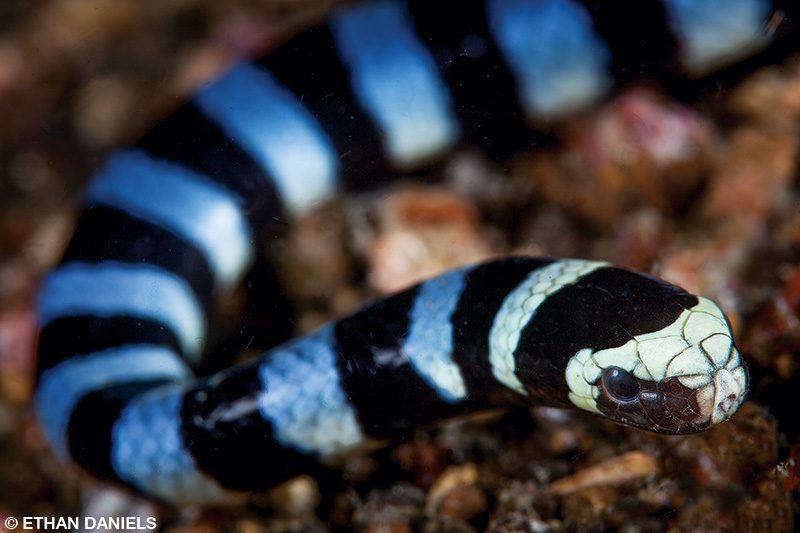Sinuous, slithery, scaly, secretive and sometimes venomous, serpents have long been the creepy stuff of nightmares. In a recent study by the Max Planck Institute for Human Cognitive and Brain Sciences in Germany, researchers concluded that humans have an evolutionary fear of snakes that may be due to our long history of coexistence.
First seen in the geologic record from approximately 167 million years ago, snakes now live on much of the planet, but very few of the more than 3,000 known living species are venomous. Sea snakes evolved much more recently and are the result of remarkable mutations, adaptations and repeated invasions into the marine world by terrestrial snake ancestors. The seas are home to more than 60 species of sea snakes that swim and hunt amid warm, shallow coral reefs, estuaries, seagrass beds, mudflats and open waters.

The diverse assembly of sea snakes includes the estuarine and coastal Asian water snakes of family Homalopsidae, nonvenomous marine file snakes of family Acrochordidae, and the family Elapidae, which includes the amphibious genus Laticauda and the more aquatic genera Aipysurus and Hydrophis. Despite how common it is for divers and snorkelers to encounter sea snakes, we still have a lot to learn about them. Their mating systems, reproductive success, population connectivity and capacity to recover following population declines are all ambiguous. Even their geographic ranges are poorly defined — some species have small geographic ranges, while others cover large swaths of the Pacific and Indian oceans.
Some sea snakes are more adapted to existing underwater than others and have evolved a suite of novel traits to improve their survival. They have evolved sensory and mating systems, respiratory adaptations and locomotion methods that succeed in the water. While vision, chemoreception and hearing are imperative for terrestrial snakes, these senses don’t mean as much underwater, and other sensory organs compensate for reduced sensory cues.
Not all species use venom; some, including the entire Elapidae family, use fangs to inject neurotoxic venom into their prey. The venom toxicity of each species reflects their specific dietary preferences. Those that feed exclusively on fish eggs, such as the beaded sea snake (Aipysurus eydouxii), have almost lost their ability to inject venom. Species that feed on prey that can quickly flee or retaliate if not rapidly immobilized have well-developed fangs and venom glands. The theory is that the coevolution between snake species and their prey influences the venom toxicity.

Among the most common sea snakes that hunt near the nooks and crannies of coral reefs are the amphibious sea kraits with their distinct banded pattern. The genus Laticauda is composed of eight species, all of which have likely evolved within the past 15 million to 20 million years. These placid reptiles breed and lay eggs on land but spend significant time hunting underwater. Sea kraits have developed unique features that permit them to excel both underwater and on land: They have a paddle-shaped tail that makes them good swimmers, yet they have retained large ventral scales that allow them to crawl efficiently on land.
Sea snakes’ unusual ability to exchange gases through their skin (cutaneous respiration) while underwater allows them to stay submerged for long periods. Several species force blood toward capillaries in their skin while underwater, permitting gas exchange with the water. Researchers discovered that the highly venomous blue-banded sea snake (Hydrophis cyanocinctus) uses a vascular network in its head to absorb oxygen from the surrounding water, acting much like a gill.1
The yellow-lipped sea krait (Laticauda colubrina) has developed skin markings and behavior patterns that might dupe predators. In habitats full of sharks, trevally and other large fishes, this sea krait is momentarily vulnerable to attack while its head is probing dark crevices for prey. Researchers have observed this sea krait twisting its tail so that the tip corresponds with the dorsal view of the head while hunting, and an observational study confirmed that all individuals of this species had a distinctive color pattern highlighting the similarity between the head and the tail.2 This deceptive coloring, along with the tail-twisting behavior, theoretically creates the illusion of a second head to present danger and avoid predation.

Many lizards and snakes have minuscule bumps on their scales called scale sensilla. Some snakes have up to 6,000 of these bumpy tactile organs that assist in sensing the surrounding environment, with the greatest density on their heads. Scientists from the University of Adelaide found that the sensilla of 19 species of sea snakes are more dome-shaped and protrude further from the scales compared those of terrestrial snakes.3 They believe that sea snakes may utilize the sensilla to detect vibrations carried through the water from any direction, like the lateral line system on fish, making it all but impossible to sneak up on a snake while underwater.
Other researchers have discovered that some sea snakes may lose their stripes to better handle polluted waters.4 The study demonstrated that banded sea snakes living in polluted areas, usually near large human population centers, are swiftly evolving to darken their light stripes. The more pigmented area on the snakes, the more harmful pollutants they can shed by sloughing their skin. This rapid evolution illustrates how organisms may handle certain environmental stresses.
One of the most intriguing questions is why sea snakes live where they do. Herpetologists theorize that the current distribution is most likely due to a combination of their origins and the biogeographic barriers that keep them from dispersing far. Though there is an entirely pelagic species — the yellow-bellied sea snake (Hydrophis platurus) — that births young at sea, most sea kraits lay their eggs on land, which limits their range. The need for fresh water is another barrier to dispersal. Recent studies have shown that, contrary to the former belief that sea kraits could get hydration from seawater, they can become dehydrated without a source of fresh water. This explains why the abundance of sea kraits in some areas can vary from year to year related to precipitation.

Unfortunately, marine reptiles of all types are declining globally due to numerous threats, including trawling, breeding habitat loss, declining water quality and climate change. Some sea snakes are already on the International Union for Conservation of Nature (IUCN) endangered list, with some listed as critically endangered. Climate change may also be affecting their biogeographic ranges due to differences in rainfall and temperature fluctuations. Warmer sea temperatures appear to increase sea snakes’ metabolic rates and shorten their dive durations, making it harder for them to locate prey. Some species have been observed outside of their typical ranges, suggesting that sea snake populations could be migrating latitudinally to adjust to ocean warming.
Those who never venture into the depths of Earth’s oceans may perceive sea snakes as primitive and menacing, but divers and snorkelers appreciate their complex behaviors and fascinating adaptations in the underwater world. Despite environmental and anthropogenic challenges for these fascinating aquatic serpents, they continue to adapt.
For all the astonishing abilities and adaptations that we know sea snakes possess, countless mysteries enshroud them and entice human curiosity. It is clear, however, that these seaworthy serpents continue to evolve generation by generation. We hope they will persist in acclimatizing to whatever future challenges unfold.
References
- Palci A, Seymour RS, Van Nguyen C, Hutchinson MN, Lee MSY, Sanders KL. Novel vascular plexus in the head of a sea snake (Elapidae, Hydrophiinae) revealed by high-resolution computed tomography and histology. R Soc Open Sci 2019; 6(9). doi:10.1098/rsos.191099
- Rasmussen AR, Elmberg J. “Head for my tail”: a new hypothesis to explain how venomous sea snakes avoid becoming prey. Mar Ecol 2009; 30(4):385-390. doi:10.1111/j.1439-0485.2009.00318.x
- Crowe-Riddell JM, Snelling EP, Watson AP, Suh AK, Partridge JC, Sanders KL. The evolution of scale sensilla in the transition from land to sea in elapid snakes. Open Biol 2016; 6(6). doi:10.1098/rsob.160054
- Goiran C, Bustamante P, Shine R. Industrial melanism in the seasnake Emydocephalus annulatus. Curr Biol 2017; 27(16):2510-2513. doi:10.1016/j.cub.2017.06.073
© Alert Diver — Q3/Q4 2020